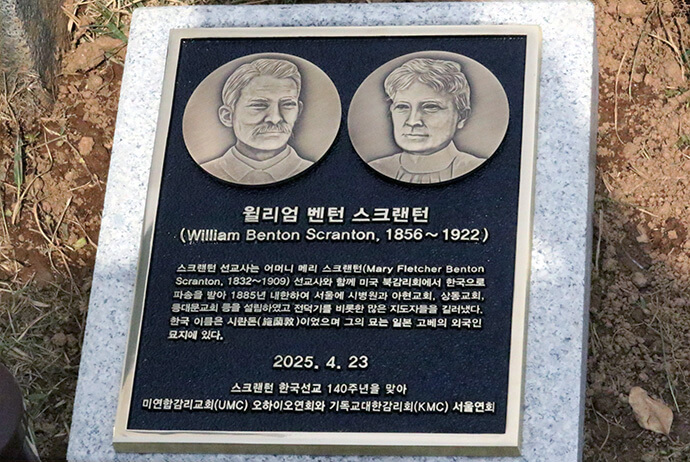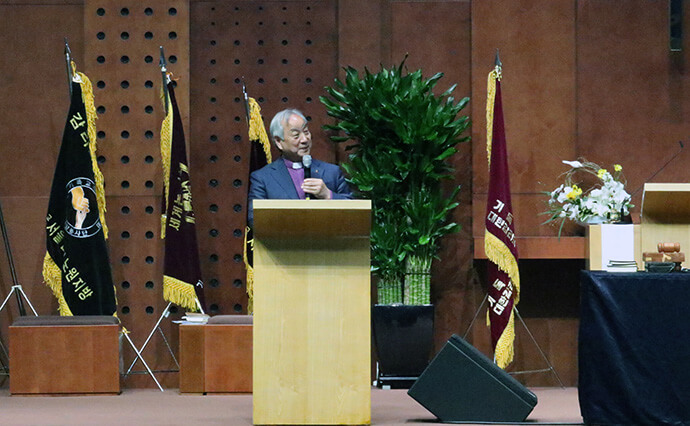Key points:
- An April visit to South Korea by United Methodist leaders from Ohio amounted to a “spiritual awakening,” said Bishop Hee-Soo Jung, who led the delegation.
- Mary Scranton and her son, William Scranton, served as missionaries in Korea in the 19th century, laying the groundwork for Methodist ministries in education and health care. A memorial stone dedicated to the Scrantons was unveiled in April.
- The Scranton family were active Methodists in Cleveland, Ohio, “making the Ohio Conference the founding conference of Korean Methodism,” according to the Rev. Lee Deok-ju, church history professor.
- The Ohio Episcopal Area will host a mission conference Aug. 4-6, commemorating 140 years of Methodism in Korea.
Thirteen United Methodist leaders from the West Ohio and East Ohio conferences, led by Bishop Hee-Soo Jung, embarked on a pilgrimage to South Korea to commemorate the 140th anniversary of Methodist mission in the country and trace the footsteps of historical missionary work.
The April 23-29 visit honored the dedication of missionaries Mary Scranton and her son, William Scranton, who were sent to Korea in 1885 to share the Gospel. It also served as an opportunity to engage with leaders of the Korean Methodist Church and reaffirm the spiritual bonds between Korean and American Methodists.
On the first day of their visit, the Ohio Episcopal Area leaders visited the Yanghwajin Foreign Missionary Cemetery in Seoul. They attended the unveiling ceremony of a memorial stone dedicated to the Scrantons. This memorial was erected under the auspices of the Scranton Commemorative Project Committee of the Korean Methodist Church’s Seoul Annual Conference and was a highlight of the delegation’s trip.

Mary Scranton, originally from Massachusetts, arrived in Korea in 1885 under the appointment of the Woman’s Foreign Missionary Society of the Methodist Episcopal Church. Deeply devoted to Korea, she once confessed during her time in Japan, “Life in Japan is enjoyable, and the living conditions for missionaries are excellent, but I want to go to my people (the Koreans) and live among them.”
Revered as a pioneer in Korean women’s education, Mary Scranton established Ewha Hakdang (Ewha Girls’ School) in 1886, opening doors of educational opportunity for women. She also founded Korea’s first women’s hospital, Bogu Yeogwan, laying the groundwork for women’s health care and education.
True to her declaration, “I will die in Korea,” she dedicated her life to the women and neighbors of Korea, passing away on Korean soil and being laid to rest in Yanghwajin.
Dr. William Scranton, a medical doctor who graduated from Yale University and New York Medical College, arrived in Seoul, Korea, in May 1885, and established a public clinic in Jeong-dong, marking the beginning of his full-fledged medical mission. However, realizing the difficulty for the poor to access the downtown clinic, he established the Good Samaritan’s Hospital on a hill outside the Sungnyemun Gate in 1888. This hospital became the origin of the present-day Ahyeon Methodist Church.

During the memorial unveiling ceremony, the Rev. Lee Deok-ju, a professor of church history at Methodist Theological University and chairman of the Institute for Korean Christian History, said William Scranton was the first Methodist missionary, arriving before Henry G. Appenzeller, a missionary who also arrived in 1885 and led the early Methodist movement in Korea.
“The Scranton family hailed from First Methodist Church in Cleveland, Ohio, essentially making the Ohio Conference the founding conference of Korean Methodism,” Deok-ju said.
“Missionary Scranton’s historical consciousness and evangelical leadership still resonate deeply today,” said Bishop Sung-bok Kim, of the Seoul Annual Conference, in his sermon during the memorial service. “It is my hope that the Ohio Conference, as the mother conference of Korean Methodism, will re-recognize its historical mission and forge new relationships.”
Following the unveiling ceremony, the delegation visited Ahyeon Methodist Church, reflecting on the early missionary efforts.
Several Ohio Episcopal Area leaders who accompanied Bishop Jung on the visit shared their hope that the passion for the Gospel would reignite across Ohio and the entire United States.
“Today, we have become too complacent in the face of the Gospel,” said the Rev. Karen Michelle Cook, the executive director of Connectional Ministries for the West Ohio Conference. “Looking back at the lives of the early missionaries who dedicated everything for the sake of the Gospel, we deeply felt the need to rekindle that passion within ourselves.”
Subscribe to our
e-newsletter
Bill Brownson, West Ohio Conference chief financial officer, said he is proud that the Ohio Conference was at the starting point of Methodist mission.
“The Christian movement always begins where people’s needs exist. Methodist mission in Korea also started with women’s education and health care, and that led to the growth of the church.”
Being present at the commemoration of the Scranton family was “a truly meaningful experience,” said the Rev. Donnetta Peaks, director of the West Ohio Conference Office of Ministry. “Furthermore, the hospitality of the Korean Church was warm and deeply resonant.” She added that her visit to the Yanghwajin Foreign Missionary Cemetery left a profound impact.
The Rev. Laura White, the superintendent of the South Forest District of the East Ohio Conference, noted, “We are relearning the rich historical legacy built over many years between Korean and American Methodists. This visit has been a precious opportunity to restore our relationship and reignite the passion that the early missionaries possessed.”
Jung defined the significance of this visit as a “spiritual awakening.”
“The United Methodist Church has recently experienced a period of spiritual stagnation amidst various challenges, including the separation within the denomination,” Jung said. “Through this visit, it is crucial for us to remember our denomination’s missionary heritage and experience a renewed awakening to carry it forward.”
He said that his appointment as bishop of Ohio was not merely a change of assignment but a calling from God. “I grew up in the Korean Church, a fruit of the Ohio mission, and now I have returned to Ohio, a 180-degree turn,” he said. “I believe God has commanded me to ‘repay the debt I owe.’”
On April 24, during the Seoul Annual Conference session held at Seoul Kkotjae (Blooming Hill) Church, Jung cited the example of John Wesley, the founder of Methodism. “The identity of the Methodist Church lies in Wesley’s faith, who declared ‘the world is my parish,’” he said. He stressed the need to study and inherit the theology and philosophy of William Scranton.
Jung specifically mentioned Scranton’s influence on the Rev. Jun Deuk-gi, a pivotal figure in the Korean independence movement during the late Joseon Dynasty and early Japanese colonial period. Jun Deuk-gi played a leading role in the Independence Club, anti-Eulsa (year 1905) Treaty protests, and the delegation sent to the 1907 Hague Peace Convention. He also organized and led the Sangdong Youth Association and the Shinminhoe (New People’s Association) and was one of the 33 national leaders who signed the Korean Declaration of Independence.
“Scranton was an honest seeker for Joseon, who did not conform to the imperialistic missionary methods of his time,” Jung said.
The Ohio Episcopal Area delegation participated in the Seoul Annual Conference, visited Methodist Theological University, Kwanglim Methodist Church, the Demilitarized Zone and Joint Security Area, and Ewha Womans University, went on a pilgrimage to Ganghwa Island, and engaged with local churches. Through these diverse experiences, they witnessed various Korean mission sites and the current state of the Methodist Church in Korea. The delegation returned to the United States on April 29.
The Ohio Episcopal Area will host a mission conference Aug. 4-6 in Cleveland, Ohio, in collaboration with the Korean Methodist Church, the United Methodist Board of Global Ministries, the United Methodist Commission on Archives and History, the Korean Ministry Plan, the Korean Association of The United Methodist Church and descendants of the Scranton family. The conference will commemorate the 140th anniversary of the Methodist mission in Korea and include academic seminars related to the Scrantons.
Kim is director of Korean and Asian news at United Methodist Communications. Contact him at 615-742-5470 or [email protected]. To read more United Methodist news, subscribe to the free UM News Digest.




